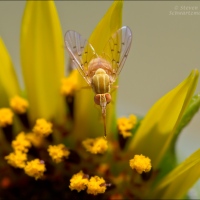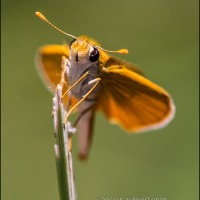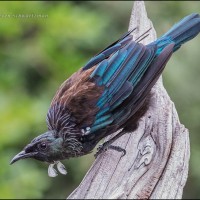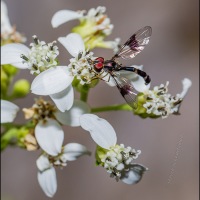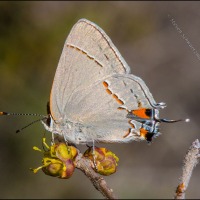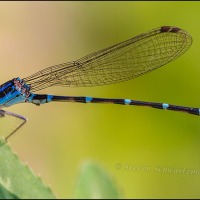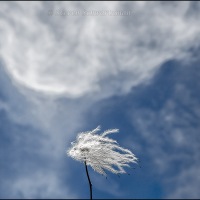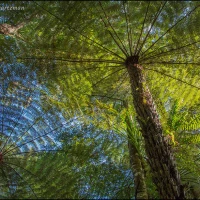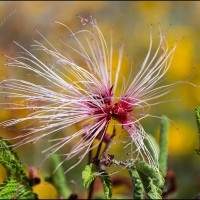Opening wildflowers portrayed with light and shadows
An April 2nd morning walk through Springfield Neighborhood Park yielded abstract portraits of two opening wildflowers, the scarlet leatherflower (Clematis texensis) above and the buttercup (Ranunculus sp.) below, in both of which the contrast between dark and light created a colorful chiaroscuro. Clicking enlarges each view.
§
§ § §
§
In a social experiment, a couple friends and I went to a Pro-Palestine protest in NYC with just American flags. The protestors’ reactions were truly shocking. Two of our flags were lit on fire and one was stolen. They praised Osama Bin Laden and chanted “death to America” This is not just a fight for Israel. This is a fight for America!
You can watch David Lederer’s 3.6-minute video showing those things.
It’s appalling what some of the people in my country have turned into.
© 2024 Steven Schwartzman
Probably the most expansive wildflower displays we’ve ever seen
On the morning of April 23rd we set out on what ended up being an 8-hour, 250-mile wildflower quest west from Austin through parts of the counties of Travis, Burnet, Llano, and Mason. Whereas the colonies of dense wildflowers you’ve seen here from Pflugerville covered undeveloped lots of up to a few acres, and similarly for recent wildflower-covered cemeteries; and whereas the large bluebonnet colonies in the four Bends extended to several times that size, the wildflower displays we witnessed on April 23rd went on for miles at a stretch, and not just at the edges of the roads but often way back into the adjacent land, sometimes as far in as we could see. The opening landscape is from FM 152 in far eastern Mason County; it marks the farthest point west we reached on our trip.
The second picture is from RM 152 at the western edge of Llano County, and the third from Llano County Road 106. The red flowers that predominated in most of the places we visited appear to be Gaillardia amblyodon, know as maroon Indian blanket (though I would go with red for the color). The white flowers are lazy daisies, Aphanostephus skirrhobasis; the yellow are brown bitterweed, Helenium amarum var. badium.

§
§ § §
§
“The very purpose of the First Amendment is to foreclose public authority from assuming a guardianship of the public mind through regulating the press, speech and religion. In this field, every person must be his own watchman for truth, because the forefathers did not trust any government to separate the true from the false for us.” — U.S. Supreme Court Justice Robert H. Jackson, 1945.
© 2024 Steven Schwartzman
Unfamiliar bluebonnet associations
On the way back south from Flat Rock Cemetery in Llano County along TX 261 on April 5th, we stopped by a highway bridge over an inlet to Lake Buchanan. Last year’s drought had dropped the lake level enough to reveal land that would normally be submerged, and bluebonnets (Lupinus texensis) were quick to colonize that land. Looking west from the bridge I saw bluebonnets together with cattails (Typha sp.), a combination I don’t often see. Another unfamiliar pairing (at least for me) came into view when I looked east from the bridge and saw a group of ducks near a large “river” of bluebonnets.
We walked a ways into the colony on the east side, where a third unfamiliar combination came my way: a fuzzy caterpillar on one of the bluebonnets.
© 2024 Steven Schwartzman
A new wildflower cemetery

After our April 5th visit to scenic and flowerful Inks Lake State Park we drove about half an hour northwest. The destination was Flat Rock Cemetery on TX 261 in Llano County, which I’d learned online currently had wildflowers on it. When I parked outside the cemetery it didn’t initially seem like much, but once I got closer and entered I found it was indeed covered with wildflowers. Most conspicuous because taller than the rest and forming yellow-green clumps was peppergrass (Lepidium sp.), which I believe I’d noticed in a cemetery just once before, and then only sparsely. As Know What Your Ancestors Knew reports:
North America has over 100 different species of Lepidium and Texas has 23. They are all very similar in appearance and edibility. The seeds have a spicy/peppery taste similar to radishes. I usually just bite the young, green seed-stalks off the plant. The young leaves also have the horse-radishy taste but by the time the seeds appear the leaves have become too power-tasting for most people to eat. The young, tender seed pods also add a bit of a kick to salads.

The cemetery was home to lots of Texas dandelions, all still in the budding stage; you can discern a little group of them standing in front of the tombstone in the second picture. The bluebonnets (Lupinus texensis) were past their prime as flowers and had already produced seed pods. A few Indian paintbrushes (Castilleja indivisa) remained fresh. And filling in the otherwise mostly bare ground by the thousands were small white daisies, presumably lazy daisies (Aphanostephus skirrhobasis).

© 2024 Steven Schwartzman
Before and after Inks Lake State Park
On April 5th we drove an hour west to Inks Lake State Park. Even before we’d quite arrived, at the intersection of TX 29 and Park Road 4 the dense wildflowers by the sides of those two roads warranted stopping. Adjacent parts of the roadside strips often looked rather different depending on which wildflowers dominated each area. The round, mostly red flower heads appear to be Gaillardia amblyodon, a different species from the familiar Indian blanket. The upright wildflowers with red-orange tops are Indian paintbrush, Castilleja indivisa. The yellow flower heads with dark centers are brown bitterweed, Helenium amarum var. badium.

And look at the way the parasitic plant called dodder (Cuscuta sp.), which has been likened to a tangle of yellow angel-hair pasta, had attacked one portion of a bluebonnet colony (Lupinus texensis).

§
Two people together have foursight.
© 2024 Steven Schwartzman
From ground to clouds
Yesterday’s post reported on my April 7th return to the great colonies of wildflowers on the prairie in the southeast quadrant of E. Pflugerville Parkway and N. Railroad Ave. in Pflugerville. Antelope horns milkweed, Asclepias asperula, figured in all three of the post’s pictures, which revealed how that species of milkweed can form a little group or even grow in a ring. Similarly, today’s top photograph shows that milkweed in colorful mixed displays of greenthread (Thelesperma filifolium), Indian paintbrush (Castilleja indivisa), Indian blanket (Gaillardia pulchella), and bluebonnet (Lupinus texensis).
Antelope horns milkweed plants may rise a few inches off the ground but tend rather to sprawl. Some of the sprawling stalks get long enough that I experimented with lifting one so I could portray it against the morning’s wispy clouds. A picture like the one above, therefore, isn’t something you’d see in nature, but it’s my nature to bring it to you. In contrast, velvet gaura (Oenothera curtiflora) grows erect and therefore needs no human intervention for a configuration like the one in today’s third photograph.
Every so often I portrayed the worthily wispy and dramatic clouds in their own right.
§
§ § §
§
Hardly a day goes by now when I don’t find another reason to despair over what’s become of my country. Yesterday an April 16th article in The Washington Examiner did it:
Chicago Public Schools teachers are instructing their eighth graders to ignore Western academic tradition, “decolonize learning,” and become political activists, according to the district’s new English curriculum.
Known as Skyline, the brand new, $135 million universal curriculum introduced by CPS in 2021 is rooted in critical race theory and diversity, equity, and inclusion ideology. While the bulk of what teachers are using to instruct children is behind password walls and largely inaccessible to parents on the school district website, a teacher inside CPS shared several of the English units with the Washington Examiner that highlighted the left-wing bent of what students there are learning.
“They want to teach [students] to think ‘correctly.’ They want to set them thinking about things like identity as soon as possible and channel their minds on propaganda,” said the longtime CPS teacher, who requested anonymity for fear of professional retribution. “The idea was that we were, for equity’s sake, going to have this curriculum where every student’s got the same thing, and the same thing was heavily infused with a very far left ideology.”
The extensive curriculums follow major themes such as an anti-Western sentiment focused on “decolonization,” far-left activism, and anti-white messaging.
Later in the article we learn that:
The focus of the curriculum comes as learning statistics from Chicago schools show unsettling results.
Both elementary and middle school reading proficiency levels in the district are at 16%, and their math proficiency is 12%. High school students in Chicago drop to 15% for reading proficiency while doing slightly better in math at 14%. In the National Assessment of Educational Progress, or NAEP, CPS eighth graders rank below that of students in most major cities while spending $18,000 per pupil.
“To put it bluntly, 14-year-old children in America’s third-largest city are barely able to read, yet instead of remediating this crisis, CPS chose to spend finite tax dollars to buy new curriculum using politically charged graphic novels,” Nicole Neily, president of Parents Defending Education, told the Washington Examiner. “Students deserve to be inspired by great literature, encouraged to pursue greatness, not to patronizingly cater to the lowest common denominator using childish cartoons.”
Like I said, one more reason to despair. You can read Breccan F. Thies’s depressing story in full.
© 2024 Steven Schwartzman
Another Pfloral Pflight to Pflugerville

On April 7th I returned to the southeast quadrant of E. Pflugerville Parkway and N. Railroad Ave. in Pflugerville, which, as you’ve seen, was a particularly good floral hotspot this spring. Though the wind had made picture-taking difficult when I stopped there late in the afternoon five days earlier, I had managed to get some good pictures. Even so, wanted a second go-round by morning light and without such a brisk wind.
Blue: Texas bluebonnet, Lupinus texensis.
Red with yellow fringes: Indian blanket, Gaillardia pulchella.
Yellow with brown center: greenthread, Thelesperma filifolium.
Off-white: antelope horns milkweed, Asclepias asperula.
Red: Indian paintbrush, Castilleja indivisa.
As with the three views from my previous stop, notice how parts of the field near one another could look rather different depending on the mix of wildflowers that had grown up.

Notice also how antelope horns milkweed tends to form a little group or even grow in a ring.
§
§ § §
§
A comment yesterday led to my finding an excellent (and funny) anti-woke commercial.
© 2024 Steven Schwartzman
Inks Lake State Park in the spring

In recent years I’ve kept exploring more and more parts of Inks Lake State Park, which has become a favorite of mine for its combination of geology and botany. On April 5th all my time went to the Pecan Flats Trail, which a ranger had recommended as the best place for wildflowers at the moment. I pushed farther along that trail than I had last year, and as I went, first one person coming my way and later another told me—presumably because they saw that I was carrying a camera—how to get to a great colony of bluebonnets (Lupinus texensis) still ahead of me. Eventually the path took me up a slope, from whose higher vantage point I was greeted with the sight you see above, which included a colony of spiderworts (Tradescantia sp.) at the left and a “lake” of bluebonnets in the distance. I continued and worked my way down close to the “lake.” Lichen-covered boulders were part of the appeal not only in that spot but throughout the park.
In many places dead trees figured prominently and added to the mix. The yellow flowers below were brown bitterweed (Helenium amarum var. badium).
And sometimes a dead tree became a subject in its own right, or at least co-starred with the clouds.
§
§ § §
§
A low-profile case decided Wednesday by the Supreme Court could have big implications for employers’ diversity, equity, and inclusion programs.
Muldrow v. City of St. Louis was a case about a female police officer who alleged that she was transferred from one department to another because of her sex. She argued that the transfer violated Title VII of the Civil Rights Act, which forbids “race, color, religion, sex, or national origin” discrimination with respect to employment “compensation, terms, conditions, or privileges.”
She lost in the lower court because she could not show that the transfer caused her “significant” harm. The lower court held that the transfer “did not result in a diminution to her title, salary, or benefits” and caused “only minor changes in [her] working conditions.”
A unanimous Supreme Court reversed, holding that any harm—whether significant or insignificant—satisfies Title VII.
So begins an April 17th article by GianCarlo Canaparo in The Daily Signal titled “High Court’s 9-0 Ruling Lowers Bar for Filing Anti-DEI Discrimination Lawsuits.” You’re welcome to read the rest of the article. Following this decision, victims of the practically ubiquitous DEI (discrimination, exclusion, injustice) programs in government, education, and corporations may more likely be able to bring and win lawsuits against the enforcers of what has quickly become a secular religion carrying out the edicts of a punitive triune god.
© 2024 Steven Schwartzman
Pfloral Pflugerville
Well into the afternoon of April 2nd, returning from a bluebonnet quest in a rural area northeast of Austin, as we approached the intersection of E. Pflugerville Parkway and N. Railroad Ave. in Pflugerville we noticed a great field of wildflowers on our left. Parking at St. Elizabeth of Hungary Catholic Church, I walked across the road to the flower-covered field to check it out. A pretty strong wind made photography difficult then, but I took some pictures anyway, figuring that even if they didn’t turn out well I could return on a calmer day.
Blue: Texas bluebonnet, Lupinus texensis.
Red with yellow fringes: Indian blanket, Gaillardia pulchella.
Yellow with brown center: greenthread, Thelesperma filifolium.
Red-orange: Indian paintbrush, Castilleja indivisa.

These three views show you how different one section of the field could look from another, depending on which wildflowers had gotten the upper hand (even though wildflowers don’t have hands).
§
§ § §
§
The most simple and pleasurable lessons of economics show you how common ideas are precisely wrong. Econ 101: Don’t confuse relative prices — one price greater than another, and the forces that push one price up relative to others — with inflation, the rise in the average level of all prices. Inflation is really about a decline in the value of money. Trying to change individual prices is a classic game of whac-a-mole.
Econ 101 week 2. During inflation, many people’s wages don’t rise as fast as prices. Giving them borrowed or printed money to make up the loss, and buy things at higher prices is another common idea. In week 2 we learn it just makes inflation worse.
These basic points seem to have escaped an entire administration, though it has been facing inflation for four years and had plenty of time to think about it.
That’s from the April 14th article “Inflation Confusion,” by “Grumpy Economist” John H. Cochrane.
You’re welcome to read the full article.
© 2024 Steven Schwartzman
A study in scarlet* (and green and black)
A post four days ago revealed that on the morning of April 2nd I went wandering through Springfield Neighborhood Park in southeast Austin. After several coral honeysuckle flowers (Lonicera sempervirens) along the path beckoned to me I heeded their colorful call and was pleased with some of the abstractions I came away with. While photographers often consider the shadows that flash casts a defect, in this case I found the shadows enhanced the composition by adding radiating linear black elements that not only echo the flowers’ red ones but also simultaneously create a third set of alternating green ones.
* Shades of Holmes and Watson
§
§ § §
§
With elections in the United States already contentious, the group called Braver Angels has issued a “Trustworthy Elections Report,” which outlines what it identifies as seven broad areas of concern:
Fair and Equal Access to Voting: Today, some citizens encounter significant barriers to voting,
while other citizens find few, if any, impediments. Our election process should strive to remove
barriers so that each citizen has an equal and reasonable opportunity to cast their vote.
Verifiable Voter Identity and Eligibility: There is some evidence, although rare, that some
voters are misrepresenting their eligibility to vote. Voters should be required to identify
themselves and prove their eligibility before casting a ballot.
Transparency and Accountability: Every citizen should be able to understand the election
process. There must be reasonable opportunities to observe election activities. The processes
related to training poll watchers and civics education should be based on best practices.
Redistricting – Gerrymandering: Voters should be able to decide who they want to govern
them. Instead, today, politicians and special interest groups draw gerrymandered redistricting
maps, through which they pick their preferred voters instead of the other way around. This
practice must end.
Confidence in Vote Counting: Every legal vote should be counted as accurately as possible.
Checks and backup documentation must be in place so that voters are assured that vote counts
are complete, accurate and unbiased.
Safety and Security in the Elections Process: Everyone involved in administering elections
must be able to do so safely and without fear of intimidation. Election processes must have robust
defenses against fraud and interference.
Peaceful Transfer of Power: Americans will not trust the outcome of elections if their leaders
sow the seeds of doubt. Candidates must ultimately accept the results of elections, provided there
is a robust process to resolve disputes. Violence must never be used to decide an election in the
United States.
You can read the report for the details of 23 specific solutions the group proposes.
© 2024 Steven Schwartzman



















